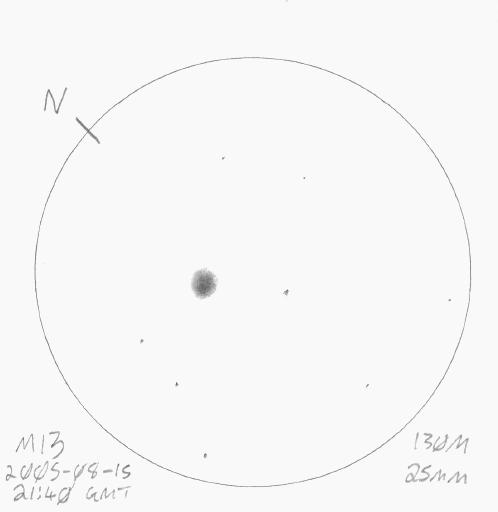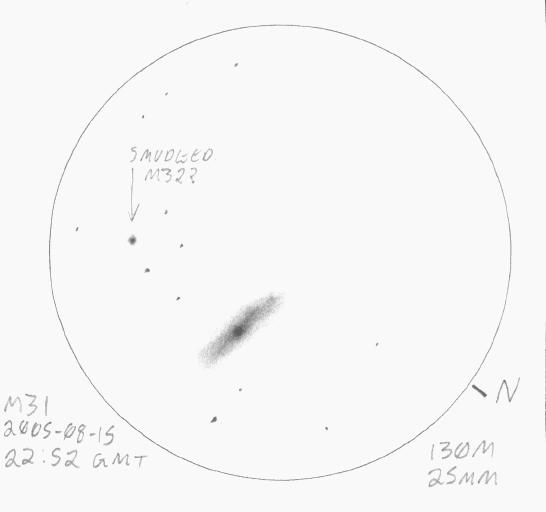2005-08-15
| Location: | Billingborough (South Lincolnshire, UK) |
| From: | 2005-08-15 20:24 UT |
| To: | 2005-08-15 22:55 UT |
| Equipment: | Naked Eye Sky-Watcher Explorer 130M |
| Notes: |
The main reason for venturing out was to give the 130M a proper "run under the stars" after center spotting the primary mirror on 2005-08-13. Also, before heading out, I use a laser collimator to try and improve the collimation. I didn't plan on doing any star-tests tonight — I just wanted to see how well I got on with the 'scope having actually had the mirror out of it. Moon was a waxing gibbous quite low in the sky (not visible from my position). There was some thin haze in parts of the sky but no noticeable clouds. Temperature was cool but still warm enough to be out in a t-shirt. When I started out the sky was still somewhat light. |
General testing
| From: | 2005-08-15 20:24 UT |
| To: | 2005-08-15 21:05 UT |
|
Started out by pointing the 'scope at Mizar. With the 25mm eyepiece there was some obvious "flaring" of the brighter stars in the field. I could also see, from time to time, a faint "rainbow" effect in the flare. At this point I had trouble recalling exactly how bright stars used to look in the 'scope. I've always seen some flaring but — never having really made a point of noting exactly how it appeared — I didn't really have anything to compare. Lesson for the future: make notes about the really obvious things such as how stars look before you do some work on your 'scope. With the 15mm eyepiece the flare (which, at times, looked like a very tight double image of each bright star) had a noticeable difference in appearance either side of best focus. When unfocused either side there was the impression of an oval effect to the unfocused stars. Either side of focus the orientation of the oval would rotate 90°. As I understand it this is evidence of astigmatism in the primary or secondary mirror! I don't think I've ever noticed this before (not that I've ever really gone looking for it before). I tried a few things to see if the oval effect would differ: I changed eyes (no difference), changed my orientation at the eyepiece (no difference) and rotated the eyepiece in the focuser (no difference). I then tested with the 10mm and then 6mm eyepieces and, as best as I could tell, the oval effect wasn't noticeable. Most confusing. The more I thought about it the more I felt that what I was seeing actually wasn't any worse than the 'scope used to be. Also, there's the fact that I don't generally know what a bright star should look like through a smallish Newtonian Reflector. I wished that I'd had Jupiter or Saturn around still so that I could compare how things looked with a more "substantial" target. |
Meteor
| Time: | 2005-08-15 21:01 UT |
|
Saw a reasonably bright meteor pass roughly North to South through Lyra. |
Probable Iridium Flare
| Time: | 2005-08-15 21:10 UT |
|
Saw a very bright Iridium Flare in Ursa Major — just below the "handle" of "The Plough". I got the impression that it was one of the brightest flares I've ever seen. It was a lot brighter than any of the stars in Ursa Major. |
M13
| From: | 2005-08-15 21:25 UT |
| To: | 2005-08-15 21:45 UT |
|
After the slight annoyance and frustration early on in the session I decided to try the 'scope out on a DSO and opted for an easy target: M13. Initial impression with the 25mm eyepiece was that it looked magnificent! While it looked like a cometary-like "blob" (as I'd noted in a previous observing session) there was, this time, the occasional faint hint that it was comprised of lots of stars. It wasn't so much that I could see stars, it was more a case of it looking slightly "grainy" from time to time. Made a sketch via the 25mm eyepiece: |
Possible "late" Perseid
| Time: | 2005-08-15 21:49 UT |
|
Saw a faint meteor pass through Andromeda. Was very quick (less than a second I'd have said) and, given the direction of travel, it looked like it might have been a "late" Perseid. |
Satellite between Cygnus and Lyra
| Time: | 2005-08-15 21:52 UT |
|
Watched a faint satellite go roughly North to South, more or less via the zenith, and pass between Cygnus and Lyra. It seemed to occult a faint (to the naked eye) star somewhere between the two constellations. Unfortunately, at the time, I wasn't in a position to note which one it was. |
M13
| From: | 2005-08-15 21:53 UT |
| To: | 2005-08-15 22:01 UT |
|
Went back to M13, this time with the 15mm eyepiece. Appeared slightly brighter. There was now a hint that it's made of actual stars with the grainy appearance mentioned above being much more pronounced. While doing viewing a thin but obscuring line of cloud (might even have been a contrail) moved into the area and made observing rather hard. Somewhat annoying as I was about to start a sketch of what it looked like with the 15mm eyepiece. |
M31 (and possibly M32)
| From: | 2005-08-15 22:12 UT |
| To: | 2005-08-15 22:55 UT |
|
M31 is now in a position where I can see it with the 'scope. First looked at it with the 25mm eyepiece. M31 itself was obvious but, at the same time, indistinct. There was an obvious brightness difference between what I assume is the central bulge and between the disk. There was no hint of any sort of structure and the whole thing had the appearance of a sort of light-gray "mist". The fact that I was looking in the direction of a street-light and that there was still a very faint haze in the sky probably wasn't helping matters. After a short while I noticed that a star in the field was actually rather "fuzzy" when compared to all the other stars. Started to wonder if what I was seeing was M32. My initial impression was that it was further away from M31 than I'd imagined it would appear to be but, that said, that impression is formed from the photographs I've seen of M31 (which obviously show a lot more of the galaxy than I'd be seeing through my 'scope). Checking with a chart I had to hand the fuzzy object did appear to be in about the right location for M32. To be sure I went and checked with my copy of Sky Atlas 2000 and, looking at that, I convinced myself that I wasn't seeing M32 (based on the pattern of stars near it which seemed to be in SA2000 but not in the correct position for M32). Lesson here: be sure of the width of the field of view of the eyepiece so you can make good estimates of separation of objects. Switched to the 15mm eyepiece. The "fuzzy star" still had a fuzzy appearance and still looked quite different from all other stars in the field. Switched back to the 25mm eyepiece and made the following sketch: At 22:55 UT I finished the session. |
Mars pops up
| Time: | 2005-08-15 22:55 UT |
|
As I was starting to pack up I noticed that Mars had popped up over the roofs of the houses to the East of me. I did consider setting up the 'scope again to have a look at it but given that it was still low down and given that it was very close to a street-light I decided to save that for another night when conditions were a little more favourable. |

